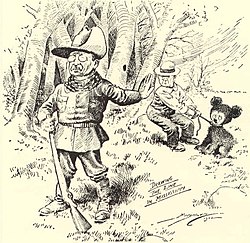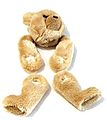Teddy bear: Difference between revisions
| [pending revision] | [pending revision] |
m Reverted edits by 98.83.71.128 (talk) to last revision by ClueBot NG (HG) |
These stores are also operating in the eu, not just in the us, you over-patriotic American, overly proud, overly ego nationalist bigoted, passive agressive idiots. |
||
| Line 37: | Line 37: | ||
Retail sales of stuffed plush animals including teddy bears was $1.3 billion in 2006.<ref>[http://library.corporate-ir.net/library/18/182/182478/items/286985/2007_AR_FINAL.pdf Build A Bear Workship Inc. 2007 Form 10-K, p.7]</ref> The most commonly sold brands include [[Gund]] and [[Ty Inc.]] Brands associated with teddy bears that enjoyed strong popularity in the 1980s and 1990s are [[Teddy Ruxpin]] and [[Care Bears]]. |
Retail sales of stuffed plush animals including teddy bears was $1.3 billion in 2006.<ref>[http://library.corporate-ir.net/library/18/182/182478/items/286985/2007_AR_FINAL.pdf Build A Bear Workship Inc. 2007 Form 10-K, p.7]</ref> The most commonly sold brands include [[Gund]] and [[Ty Inc.]] Brands associated with teddy bears that enjoyed strong popularity in the 1980s and 1990s are [[Teddy Ruxpin]] and [[Care Bears]]. |
||
Teddy bears have seen a resurgence in popularity as |
Teddy bears have seen a resurgence in popularity as international "do-it-yourself" chains have opened. Among the largest and best-known are [[Build-A-Bear Workshop]] and [[Vermont Teddy Bear Company]]. |
||
Some popular mass-marketed teddy bears made today include [[Rupert Bear|Rupert]], [[Sooty]], [[Paddington Bear|Paddington]], and [[Children in Need#History|Pudsey Bear]]. Books have also been written with the teddy bear featured as their main character. These include [[Winnie-the-Pooh]], [[Corduroy]], [[Teddy Tells Time]], and [[Teddy Dressing]]. |
Some popular mass-marketed teddy bears made today include [[Rupert Bear|Rupert]], [[Sooty]], [[Paddington Bear|Paddington]], and [[Children in Need#History|Pudsey Bear]]. Books have also been written with the teddy bear featured as their main character. These include [[Winnie-the-Pooh]], [[Corduroy]], [[Teddy Tells Time]], and [[Teddy Dressing]]. |
||
Revision as of 22:01, 20 December 2010
The teddy bear is a stuffed toy bear. They are usually stuffed with soft, white cotton and have smooth and soft fur. It is an enduring form of a stuffed animal in many countries, often serving the purpose of entertaining children. In recent times, some teddy bears have become collector's items.[1] Now, teddy bears come in various styles and people can dress them up in many different styles and articles of clothing. Teddy bears are also among the most popular gifts for children and significant others on Valentine's Day, birthdays, Christmas and other holidays.
History


The name Teddy Bear comes from former United States President Theodore Roosevelt, whose nickname was "Teddy". The name originated from an incident on a bear-hunting trip in Mississippi in November 1902, to which Roosevelt was invited by Mississippi Governor Andrew H. Longino. There were several other hunters competing, and most of them had already killed an animal. A suite of Roosevelt's attendants, led by Holt Collier,[2] cornered, clubbed, and tied an American Black Bear to a willow tree after a long exhausting chase with hounds. They called Roosevelt to the site and suggested that he should shoot it. He refused to shoot the bear himself, deeming this unsportsmanlike,[3] but instructed that the bear be killed to put it out of its misery[citation needed], and it became the topic of a political cartoon by Clifford Berryman in The Washington Post on November 16, 1902.[4] While the initial cartoon of an adult black bear lassoed by a white handler and a disgusted Roosevelt had symbolic overtones, later issues of that and other Berryman cartoons made the bear smaller and cuter.[5]
Morris Michtom saw the drawing of Roosevelt and the bear cub and was inspired to create a new toy. He created a little stuffed bear cub and put it in his shop window with a sign that read "Teddy's bear," after sending a bear to Roosevelt and receiving permission to use his name. The toys were an immediate success and Michtom founded the Ideal Novelty and Toy Co.[3]
At the same time in Germany, the Steiff firm, unaware of Michtom's bear, produced a stuffed bear from Richard Steiff's designs. They exhibited the toy at the Leipzig Toy Fair in March 1903 and exported 3,000 to the United States.[6][7]
By 1906 manufacturers other than Michtom and Steiff had joined in and the craze for "Roosevelt Bears" was such that ladies carried them everywhere, children were photographed with them, and Roosevelt used one as a mascot in his bid for re-election.[6]
American educator Seymour Eaton wrote the children's book series The Roosevelt Bears,[8] while composer John Bratton wrote "The Teddy Bear Two Step" which, with the addition of Jimmy Kennedy's lyrics, became the song "The Teddy Bears' Picnic".[9]
Early teddy bears were made to look like real bears, with extended snouts and beady eyes. Today's teddy bears tend to have larger eyes and foreheads and smaller noses, babylike features that make them more attractive to buyers because they enhance the toy's cuteness. Also, now some bears come pre-dressed, sometimes for winter, spring, summer, or fall.
Production
Commercially-made, mass-produced teddy bears are predominantly made as toys for children. These bears have safety joints for attaching arms, legs, and heads. They must have securely fastened eyes that do not pose a choking hazard for small children. These "plush" bears must meet a rigid standard of construction in order to be marketed to children in the United States and in the European Union.
There are also companies, like Steiff, that sell handmade collectible bears that can be purchased in stores or over the Internet. The majority of teddy bears are manufactured in countries such as China and Indonesia. A few small, single-person producers in the United States make unique, non-mass produced teddy bears. One of the oldest remaining American manufacturers that produces "Made in the USA" teddy bears is Stuffington Bear Factory, open since 1959.[10]

Mohair, the fur shorn or combed from a breed of long haired goats, is woven into cloth, dyed and trimmed. Alpaca teddy bears are made from the pelt of an alpaca because the fiber is too soft to weave. In addition to mohair and alpaca, there is a huge selection of "plush" or synthetic fur made for the teddy bear market. Both these types of fur are commercially produced.
Some teddy bear artists specialize in the production of bears made from recycled materials. These artists hunt thrift stores, flea markets, garage sales and trash collection centers as well as their own and their families' basements and attics in search of forgotten treasures to be turned into a collector's dream. Old quilts, dresses, fur collars, coats and stoles as well as beaded bags and garments are quickly transformed into stunning teddy bears.
Some teddy bear artists specialize in crochet bears made out of thread. For these bears artists do not use fabric; they make the fabric crocheting and at the same time make the bear. Thread crochet bears are fully-jointed, miniature bears. They may be made out of cotton crochet thread, eyelash yarn, or other fiber.
Like already seen, the most teddy bear manufactures make bears with their own style. That leads to different favorite bears brands, like the Belgium Noukie's or the Steiff bears.
Popularity

Retail sales of stuffed plush animals including teddy bears was $1.3 billion in 2006.[11] The most commonly sold brands include Gund and Ty Inc. Brands associated with teddy bears that enjoyed strong popularity in the 1980s and 1990s are Teddy Ruxpin and Care Bears.
Teddy bears have seen a resurgence in popularity as international "do-it-yourself" chains have opened. Among the largest and best-known are Build-A-Bear Workshop and Vermont Teddy Bear Company.
Some popular mass-marketed teddy bears made today include Rupert, Sooty, Paddington, and Pudsey Bear. Books have also been written with the teddy bear featured as their main character. These include Winnie-the-Pooh, Corduroy, Teddy Tells Time, and Teddy Dressing.
Teddy bear museums
The world's first Teddy Bear Museum was set up in Petersfield, Hampshire, England, in 1984. In 1990, a similar foundation was set up in Naples, Florida, United States. These were closed in 2006 and 2005 respectively, and the bears were sold in auctions, but there are today many Teddy Bear Museums around the world.[12]
Teddy bear cops
Because police, fire and emergency officials found that giving a teddy bear to a child during a crisis stabilized them, NAPLC created the Teddy Bear Cops program to distribute teddy bears to police, fire, and emergency officials throughout the United States, for their use in providing teddy bears to children in emergency situations.[13][14]
Teddy bear festivals
Teddy bear festivals have now become popular around the world, taking place in America, Canada, Great Britain, Japan and Germany. A prime example of a such a festival can be seen in the Mitzi TV video "Bear Necessities".[15]


Brunus edwardii joke
In April 1972, issue 90 of The Veterinary Record included a paper on the diseases of Brunus edwardii: a description of lost limbs and thinning hair suffered by an animal whose Latin name means "bear" and "Edward". The paper was accompanied by sketches of a teddy bear resembling Winnie the Pooh.[16][17]
Making a teddy bear gallery
-
1:Cutting
-
2:Sewing and turning
-
3:Filling
-
4:Assembling
References
- ^ "A STEIFF HARLEQUIN TEDDY BEAR, jointed, half red and half blue mohair, one blue and black and one brown and black glass eye, black stitching, yellow felt pads and FF button, circa 1925 --13½in. (34cm.) high (small bald spot below right ear, some fading mainly to the blue, blue eye cracked, patch to right pad and some general wear) Christie's". Retrieved 2010-10-12.
Estimate £50,000 - £80,000
- ^ U.S. Fish and Wildlife Service Holt Collier: Guiding Roosevelt through the Mississippi Canebreaks
- ^ a b "Teddy Bears". Library Of Congress. Retrieved 2007-12-10.
- ^ Marianne Clay. "The History of the Teddy Bear". Retrieved 2007-12-10.
- ^ Theodore Roosevelt Association. The story of The Teddy Bear...
- ^ a b Gary. "Teddy Bear Information". Retrieved 2008-03-03.
- ^ Teddy bear celebrates 100th birthday BBC, 2002-12-03
- ^ "Seymour Eaton". Greater Lansdowne Civic Association (GLCA). 2003. Retrieved 2007-12-10.
- ^ "Teddy Bear Picnic". Marc Gunn. Retrieved 2007-12-10.
- ^ Stuffington Bear Factory - Made in the USA
- ^ Build A Bear Workship Inc. 2007 Form 10-K, p.7
- ^ Huggableteddybears.com
- ^ Emergency Officials
- ^ Officers using the Teddy Bear Cops program
- ^ Mitziszereto.com
- ^ "The April fool's day database". Brunus edwardii (1972). 1972. Retrieved 27 March 2010.
- ^ Blackmore, DK (1972). "Some observations on the diseases of Brunus edwardii (Species nova)". Veterinary Record (90): 382–385. Retrieved 27 March 2010.
{{cite journal}}: Unknown parameter|coauthors=ignored (|author=suggested) (help)



